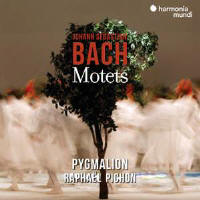Texte paru dans: / Appeared in: |
|
|
Outil de traduction (Très approximatif) |
|
|
Reviewer: Peter Quantrill A whole generation has elapsed since René Jacobs’s much admired disc of Bach motets (Harmonia Mundi, 7/97), and even its high points now seem a little pallid by the side of the relaxed virtuosity and deft word-painting of Pygmalion. The continuo ensemble, while not omitting doubling elements of string bass and chamber organ, gives pride of place in the mix to archlute and theorbo, which punctuate cadences with a Monteverdian sprezzatura. The sudden resort to pure a cappella, as in the central section of Singet dem Herrn, becomes all the more effective for its restraint. The catholic outlook of Bach’s instrumental music, aesthetically speaking, is emulated by the motets to a degree unique in his vocal output. Raphaël Pichon’s direction is accordingly mindful of the expressive distance between the sensuous, madrigalian tone-painting of Komm, Jesu, komm and the more formal juxtaposition of chorale and contrapuntal techniques in Jesu, meine Freude. To take the busy flourishes of Der Geist hilft as a surprising example, however, his inclination tends towards a species of dramatic realisation that would hardly find a natural home in the choir loft of the Thomaskirche, and yet feels conceived on a scale larger than the chamber-music values cultivated at the Café Zimmermann. Italian opera troupes visited Bach’s Leipzig; as did the celebrated lutenist Sylvius Leopold Weiss in 1739. I can quite imagine them together moulding and lingering over the falling phrases of Fürchte dich nicht in Pygmalion’s style. No doubt my imaginary company would also have known what to do with Pichon’s pertinently interleaved illustrations of motet designs from earlier generations, from the cool marble columns of Bertolusi’s counterpoint to the bare, devotional expanses of Jacob Handl. As they have done in so many other areas of concerted Bach performance, Harnoncourt (Teldec/Warner, 5/81) and Gardiner (SDG, 8/12) set the pace for the motets on record. Their approaches are persuasively more consistent, also more ‘churchy’ while no less text-sensitive, but this sumptuously engineered album strikes a contemporary consonance within a spectrum of spiritual vocal writing from Marenzio to Whitacre. |
|




